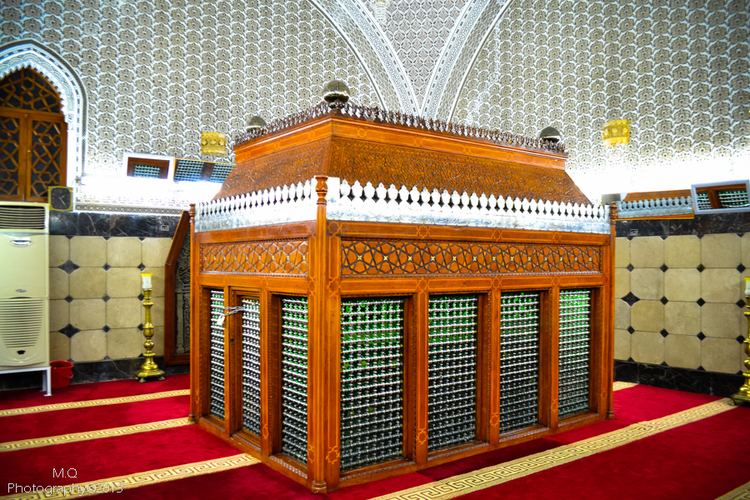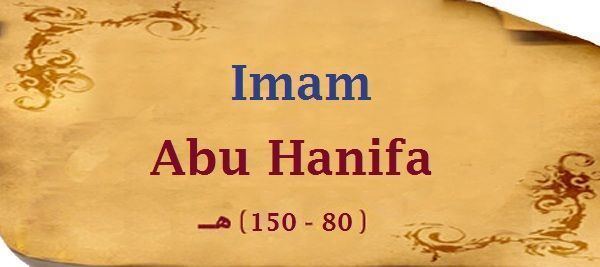Title Imam e Azam Jurisprudence Sunnah Parents Thabit bin Zuta | Region Muslim World Role Imam Ethnicity Persian Name Abu Hanifa | |
 | ||
Similar People Al‑Shafi‘i, Malik ibn Anas, Ahmad ibn Hanbal, Muhammad al‑Bukhari, Al‑Ghazali | ||
1 biography of imam abu hanifah part 1 of 7
Abū Ḥanīfa al-Nuʿmān b. Thābit b. Zūṭā b. Marzubān (Arabic: أبو حنيفة نعمان بن ثابت بن زوطا بن مرزبان), known as Abū Ḥanīfa for short, or reverently as Imam Abū Ḥanīfa by Sunni Muslims, was an 8th-century Kufan Sunni Muslim theologian and jurist, who became the eponymous founder of the Hanafi school of orthodox Sunni jurisprudence, which has remained the most widely-practiced law school in the Sunni tradition. He is often alluded to by the reverential epithets al-Imām al-aʿẓam ("The Greatest Leader") and Sirāj al-aʾimma ("The Lamp of the Leaders") in Sunni Islam.
Contents
- 1 biography of imam abu hanifah part 1 of 7
- Imam Abu Hanifa RA
- Childhood
- Adulthood and death
- Generational status
- Reception
- Works
- Confusion regarding Al Fiqh Al Akbar
- References

Born to a Muslim family in Kufa, Abu Hanifa is known to have travelled to the Hejaz region of Arabia in his youth, where he studied under the most renowned teachers in Mecca and Medina at the time. As his career as a theologian and jurist progressed, Abu Hanifa became known for favoring the use of reason in his legal rulings (faqīh dhū raʾy) and even in his theology. Abu Hanifa's theological school is what would later develop into the Maturidi school of orthodox Sunni theology.

He is also considered a renowned Islamic scholar and personality by Zaydi Shia Muslims.

Imam Abu Hanifa [RA]
Childhood

Abū Ḥanīfah was born in the city of Kufa in Iraq, during the reign of the Umayyad caliph Abd al-Malik ibn Marwan. His father, Thabit bin Zuta, a trader from Kabul, Afghanistan, was 40 years old at the time of Abū Ḥanīfah's birth.

His ancestry is generally accepted as being of Persian origin as suggested by the etymology of the names of his grandfather (Zuta) and great-grandfather (Mah). The historian Al-Khatib al-Baghdadi records a statement from Imām Abū Ḥanīfah's grandson, Ismail bin Hammad, who gave Abū Ḥanīfah's lineage as Thabit bin Numan bin Marzban and claiming to be of Persian origin. The discrepancy in the names, as given by Ismail of Abū Ḥanīfah's grandfather and great-grandfather, are thought to be due to Zuta's adoption of the Arabic name (Numan) upon his acceptance of Islam and that Mah and Marzban were titles or official designations in Persia, with the latter, meaning a margrave, referring to the noble ancestry of Abū Ḥanīfah's family as the Sasanian Marzbans (equivalent of margraves) of Kabul (Modern day Afghanistan). Those stories maintain for his ancestors having been slaves purchased by some Arab benefactor are, therefore, untenable and seemingly fabricated. There is a discussion on being of Turkic or Persian origin. But the widely accepted opinion, however, is that most probably he was of Persian ancestry from Kabul.
Adulthood and death
In 763, al-Mansur, the Abbasid monarch offered Abu Hanifa the post of Chief Judge of the State, but he declined the offer, choosing to remain independent. His student Abu Yusuf was later appointed Qadi Al-Qudat (Chief Judge of the State) by the next Caliph Harun al-Rashid.
In his reply to al-Mansur, Abū Ḥanīfah said that he was not fit for the post. Al-Mansur, who had his own ideas and reasons for offering the post, lost his temper and accused Abū Ḥanīfah of lying.
"If I am lying," Abū Ḥanīfah said, "then my statement is doubly correct. How can you appoint a liar to the exalted post of a Chief Qadi (Judge)?"
Incensed by this reply, the ruler had Abū Ḥanīfah arrested, locked in prison and tortured. He was never fed nor cared for. Even there, the jurist continued to teach those who were permitted to come to him.
In 767, Abū Ḥanīfah died in prison. The cause of his death is not clear, as some say that Abū Ḥanīfah issued a legal opinion for bearing arms against Al-Mansur, and the latter had him poisoned. It was said that so many people attended his funeral that the funeral service was repeated six times for more than 50,000 people who had amassed before he was actually buried. On the authority of the historian al-Khatib, it can be said that for full twenty days people went on performing funeral prayer for him. Later, after many years, the Abū Ḥanīfah Mosque was built in the Adhamiyah neighbourhood of Baghdad.
The tomb of Abū Ḥanīfah and the tomb of Abdul Qadir Gilani were destroyed by Shah Ismail of Safavi empire in 1508. In 1533, Ottomans conquered Baghdad and rebuilt the tomb of Abū Ḥanīfah and other Sunni sites.
Generational status
Abū Ḥanīfah is regarded by some as one of the Tabi‘un, the generation after the Sahaba, who were the companions of the Islamic prophet, Muhammad. This is based on reports that he met at least four Sahaba including Anas ibn Malik, with some even reporting that he transmitted Hadith from him and other companions of Muhammad. Others take the view that Abū Ḥanīfah only saw around half a dozen companions, possibly at a young age, and did not directly narrate hadith from them.
Abū Ḥanīfah was born 67 years after the death of Muhammad, but during the time of the first generation of Muslims, some of whom lived on until Abū Ḥanīfah's youth. Anas bin Malik, Muhammad's personal attendant, died in 93 AH and another companion, Abul Tufail Amir bin Wathilah, died in 100 AH, when Abū Ḥanīfah was 20 years old. The author of al-Khairat al-Hisan collected information from books of biographies and cited the names of Muslims of the first generation from whom it is reported that the Abu Hanifa had transmitted hadith. He counted them as sixteen, including Anas ibn Malik, Jabir ibn Abd-Allah and Sahl ibn Sa'd.
Reception
Abu Hanifa ranks as one of the greatest jurists of Islamic civilization and one of the major legal philosophers of the entire human community. He attained a very high status in the various fields of sacred knowledge and significantly influenced the development of Muslim theology. During his lifetime he was acknowledged by the people as a jurist of the highest calibre.
Outside of his scholarly achievements Abu Hanifa is popularly known amongst Sunni Muslims as a man of the highest personal qualities: a performer of good works, remarkable for his self-denial, humble spirit, devotion and pious awe of God.
His tomb, surmounted by a dome erected by admirers in 1066 is still a shrine for pilgrims. It was given a restoration in 1535 by Suleiman the Magnificent upon the Ottoman conquest of Baghdad.
The honorific title al-Imam al-A'zam ("the greatest leader") was granted to him both in communities where his legal theory is followed and elsewhere. According to Dr. John Esposito, 45% of traditional Muslims (41% of all Muslims) follow the Hanafi school.
Abu Hanifa also had critics. The Zahiri scholar Ibn Hazm quotes Sufyan ibn `Uyaynah: "[T]he affairs of men were in harmony until they were changed by Abù Hanìfa in Kùfa, al-Batti in Basra and Màlik in Medina". Early Muslim jurist Hammad ibn Salamah once related a story about a highway robber who posed as an old man to hide his identity; he then remarked that were the robber still alive he would be a follower of Abu Hanifa.
Works
Confusion regarding Al-Fiqh Al-Akbar
The attribution of Al-Fiqh Al-Akbar has been disputed by A.J. Wensick, as well as Zubair Ali Zai.
Other scholars have upheld that Abu Hanifa was the author such as Muhammad Zahid Al-Kawthari, al-Bazdawi, and Abd al-Aziz al-Bukhari.
Scholars such as Mufti Abdur-Rahman have pointed out that the book being brought in question by Wensick is actually another work by Abu Hanifa called: "Al-Fiqh Al-Absat".
